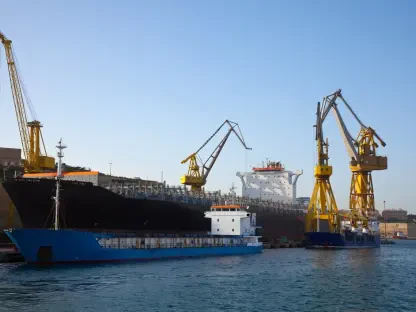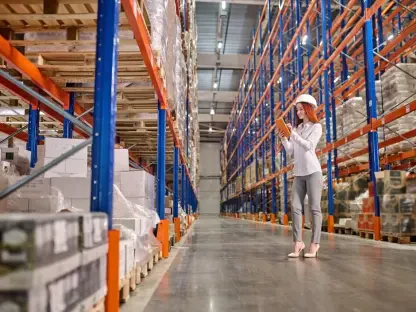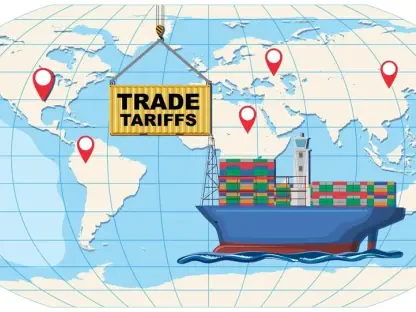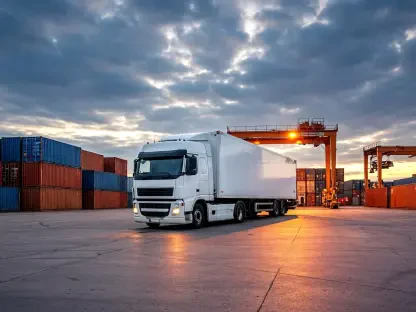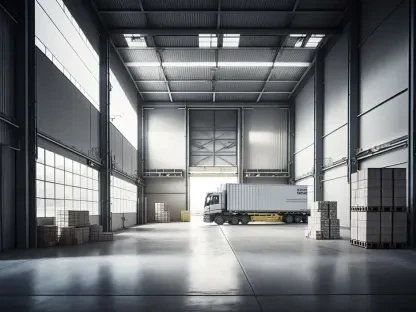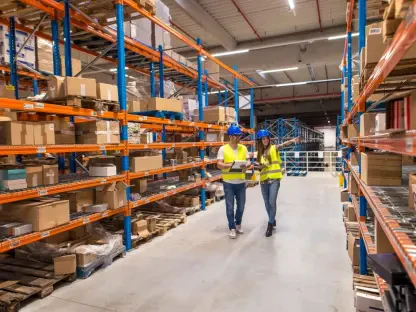The American logistics landscape is currently undergoing a significant transformation, predominantly driven by advancements in logistics automation. This sector’s evolution is marked by the integration of sophisticated technologies that are poised to redefine supply chain efficiency. By 2030, the logistics automation market is expected to reach a substantial valuation, reflective of its increasing importance across various industry sectors.Key drivers of growth in this area include the ever-increasing demand for faster and more reliable delivery methods, the necessity for cost reduction in supply chain management, and the ongoing push towards digital transformation. As businesses strive to meet consumer expectations for quick turnaround times, automation technologies such as robotics, AI, and machine learning are becoming integral to warehouse operations, inventory management, and transportation logistics.These advancements are not only enhancing productivity but also helping to address labor shortages and reduce human error. However, the shift towards automated logistics also presents challenges, including the need for significant capital investments and concerns over potential job displacement.The implications of automated logistics are far-reaching, influencing industries from manufacturing to retail. As businesses adopt these technologies to stay competitive, it’s essential to consider the long-term impacts on the workforce, the economy, and the overall dynamics of the trading ecosystem. As such, logistics automation stands out as a key element shaping the future of American commerce and industry.
Market Growth and Key Projections
Current Market Valuation and Expected Trends
Standing at a valuation of USD 44 billion in 2024, the US logistics automation market is on a trajectory that promises substantial growth over the next six years. Analysts predict that by 2030, this market could soar to USD 103.75 billion, propelled by a Compound Annual Growth Rate (CAGR) of 10%. This projected growth is not just a byproduct of expanding e-commerce and retail sectors but also a testament to the critical role of automation in enhancing supply chain efficiency and reliability across several industries. To fully understand this upward trend, it is necessary to delve into key market dynamics, such as the increased need for accurate inventory management, the push towards faster delivery times, and the heightened emphasis on cost-efficiency in logistics operations. These factors collectively contribute to the heightened demand for sophisticated automation solutions capable of transforming logistical challenges into competitive advantages.
Factors Contributing to Market Expansion
A myriad of factors synergistically propel the growth of the logistics automation market. Key among these is the pervasive digital transformation sweeping across all industrial sectors, compelling companies to reassess and reinvent their logistical frameworks. Enterprises increasingly invest in high-tech solutions like robotics, AI, and machine learning to streamline processes, mitigate risks, and reduce operational costs.Simultaneously, advancements that cater to the rising environmental and regulatory pressures, like green logistics, are leading companies to seek out more sustainable and compliant logistical solutions. Be it through warehouse automation, which minimizes human intervention and error, or advanced transportation management systems that optimize routes and reduce carbon emissions, the pursuit of a greener supply chain heavily influences market growth.
Automation Components and Applications
Hardware-Integrated Systems and Software Solutions
Logistics automation is an orchestration of several complex components, each playing a vital role in streamlining supply chain operations. At the forefront are hardware systems that include autonomous mobile robots (AMRs), automated guided vehicles (AGVs), and conveyor systems that significantly reduce manual labor and enhance throughput. As online consumer demands escalate, these hardware solutions are evolving to offer greater flexibility, speed, and accuracy, making them indispensable in the logistics of the future.In conjunction with the hardware, the market is witnessing innovations in logistics automation software. The pivot towards cloud-based Warehouse Management Systems (WMS) and Transportation Management Systems (TMS) are prime examples. These platforms offer end-to-end visibility, real-time data analytics, and predictive modeling capabilities. As companies look to harness big data and IoT, these software solutions play a critical role in enabling smarter, more proactive decision-making.
Services Supplementing the Technology
Implementing automated logistics solutions is a complex endeavor, necessitating a range of support services that ensure seamless integration and optimal performance. Consultation services are the cornerstone, as they help companies tailor solutions that align with business objectives and navigate through the challenges of technological adoption. Following consultation, implementation services take the spotlight, translating proposed plans into actual systems working on the warehouse or transportation network floor. Beyond mere installation, these services involve process re-engineering, workforce training, and performance optimization. The post-implementation phase is equally important. It involves ongoing support and maintenance services that guarantee the reliability and longevity of the automation solutions, ensuring they evolve with changing market demands and technological upgrades.
Industry-Specific Adoption of Logistics Automation
Manufacturing, Healthcare, and Retail Sectors
The manufacturing sector finds logistics automation instrumental in addressing aspects like JIT inventory management and flexible production demands. For healthcare and pharmaceuticals, maintaining strict conditions, ensuring swift distribution of sensitive products, and compliance tracking are pivotal. Automation within these sectors reduces errors and enhances speed, contributing to better patient outcomes and efficiency.The retail realm, especially in the era of e-commerce, reaps substantial rewards from logistics automation. Consumer expectations for rapid delivery and seamless returns have driven retailers to adopt intelligent warehousing solutions and dynamic routing systems. The agility and accuracy that automation provides are now non-negotiable aspects of retail logistics, redesigning the very fabric of how this sector operates.
Emerging Sectors: E-Commerce, 3PL, and More
As the e-commerce sector booms, the reliance on cutting-edge logistics automation has become more pronounced. Companies utilize intricate automated storage and retrieval systems (AS/RS) to ensure the quick dispatch of online orders. Third-party logistics (3PL) providers are also heavily investing in automation technologies to offer advanced services to their clientele, thereby fostering greater resilience and adaptability in a complex supply chain landscape.Moreover, the integration of automation in other nascent sectors such as aerospace, defense, and energy showcases the broad spectrum of its application. Enhanced inventory tracking, increased throughput, and heightened security and compliance adherence in these sectors further validate the indispensable role of logistics automation as a cornerstone of modern supply chain practices.
Regional Market Analysis
North America’s Leadership Role
The United States stands as a juggernaut in the logistics automation market, a position fortified by advanced infrastructure, a culture of innovation, and substantial technological investments. Corporations and startups alike are pushing the envelope, cementing North America’s hold on market leadership. This dominant stance is expected to persist, propelled by a steady march towards more refined, autonomous, and integrated logistics ecosystems.In addition to industry willingness to adopt new technologies, the United States’ economy benefits from robust investment strategies and a supportive regulatory framework that encourages research and development. This mature ecosystem becomes a beacon for what’s possible in logistics automation, influencing trends and setting benchmarks for the global markets.
The Asia-Pacific Market Surge
The Asia-Pacific region is experiencing a boom in logistics automation, fueled by rapid economic growth and industrialization within its key players—China, India, and South Korea. As these countries evolve into manufacturing powerhouses, automation becomes a strategic investment to ensure they operate at international standards and peak efficiency.This momentum in automation is setting the Asia-Pacific region on a trajectory that could challenge or further enhance North America’s leading role in the sector. The region’s embrace of cutting-edge technologies, combined with a massive consumer population, marks it as a significant player in the global logistics automation scene.Poised at the edge of innovation, Asia-Pacific’s logistics sector is adapting rapidly to meet the demands of its growing economy. Global investors and companies are particularly attentive to the area, anticipating a wave of advancements that could dictate future trends in logistics and supply chain management. With its strategic moves toward automation, the Asia-Pacific is becoming a critical region to observe, as its developments may redefine efficiency and competitiveness in the logistics industry worldwide.
The Trajectory of Digital Transformation and Smart Technology
Logistics Automation in the Digital Age
Logistics automation is a key player in the broader digital transformation narrative. As industries around the world pivot towards a more interconnected, data-driven business model, logistics processes are bordering on complete digitization. Automation has emerged as both a catalyst and a beneficiary of this shift. Fusing the physical and digital realms of logistics operations, automation streamlines workflows, enhances data transparency, and emphasizes the need for cyber-physical systems to optimize the entire supply chain continuum.As organizations continue to adopt digital-first strategies, logistics automation technologies are evolving in parallel, learning to extract more data, predict outcomes, and self-optimize. In essence, logistics automation is not merely a tool but a strategic partner in the digital age, offering newfound agility and insight into the mechanics of modern business.
Smart Technologies Spearheading Competitiveness
Smart technologies are the vanguard of competitive logistics. Resources such as AI-powered customer service bots, blockchain for supply chain integrity, and the Internet of Things (IoT) for inter-device communication are dramatically altering how companies manage logistics. This evolution is notably visible in the area of customer service, where accuracy, speed, and personalization have become distinguishing factors. As companies leverage smart technologies to refine these parameters, automation becomes a linchpin, optimizing resource allocation, delivery routes, and responses to unforeseen disruptions. The resulting operational robustness and precision lead not only to cost savings but also to enhanced customer satisfaction and loyalty, solidifying a company’s competitive edge in a crowded marketplace.As logistics automation continues to redefine the parameters within which supply chains operate, its evolving narrative is expected to be a compelling one. This exploration has offered a balanced, comprehensive view that reflects the dynamism and complexity of the US logistics automation market and its trajectories leading up to 2030.


